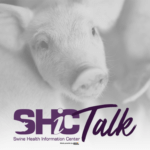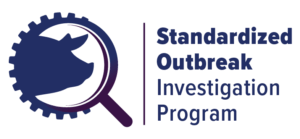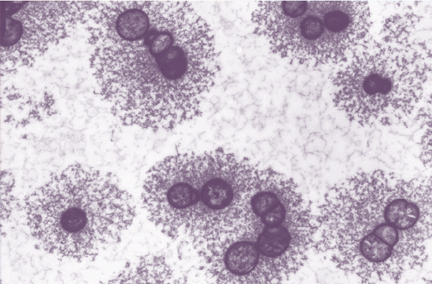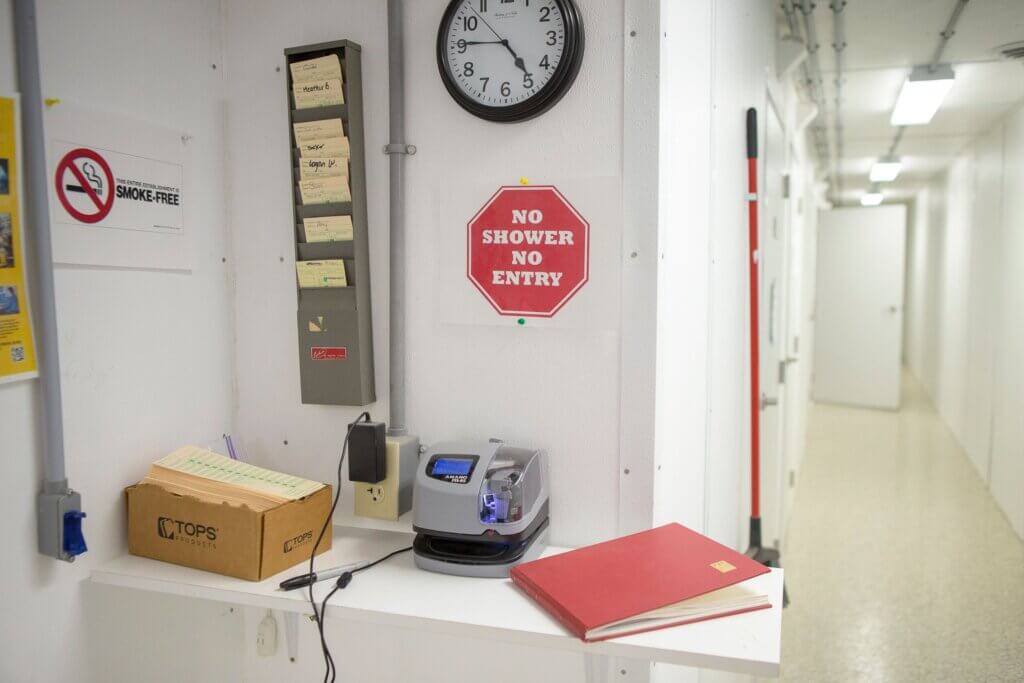
The Swine Health Information Center, launched in 2015 with Pork Checkoff funding, protects and enhances the health of the US swine herd by minimizing the impact of emerging disease threats through preparedness, coordinated communications, global disease monitoring, analysis of swine health data, and targeted research investments.
This will be my last edition of the SHIC newsletter as SHIC’s executive director with my retirement coming at year end. As I’ve traveled across North America and around the world during my tenure, I’ve been honored to be welcomed and able to talk with you about emerging swine diseases and SHIC’s effort to mitigate them. Our exchanges have helped shape SHIC’s evolving vision. I’ve truly been blessed having this opportunity and I know you will continue to value SHIC’s contributions in the future as Dr. Niederwerder and Dr. Becton carry on this important work. Thanks to each of you for your support and kind words.



Porcine epidemic diarrhea virus. The 2013 outbreak of this emerging swine disease in the US pork industry was a pivotal moment for producers, those serving them, and specifically Dr. Paul Sundberg who at the time was vice president of science and technology at the National Pork Board.
Answering all the questions related to how an emerging disease entered the US, spread, and dramatically impacted pigs and producers’ livelihoods became a significant focus for Dr. Sundberg, colleagues, and collaborators. The specter of emerging swine disease had always been a concern but became a crisis. And PEDV’s impact was the catalyst for creation of the Swine Health Information Center, an organization with the mission of protecting the health of the US swine herd from emerging disease threats through prevention, preparedness, response, and research activities.
As SHIC was conceived, the need for a leader to guide the new organization was clear. Few had the experience, qualifications, drive, and relationships to step into what was a concept and make it a functioning and relevant organization. Dr. Sundberg was the right person at the right time for the task, leading the organization since its launch in July 2015 and now moving into well-deserved retirement in December 2023.
“The goal of the original board of directors of SHIC was to find that perfect individual to oversee the entity. Someone who was passionate about protecting the North American swine population from an introduction of any foreign animal disease, was respected and extremely well connected with all facets of the industry and had knowledge and experience in swine health and research,” explained Daryl Olsen, DVM, AMVC and SHIC board member. “Dr. Paul Sundberg was the perfect choice. He has led the organization since its inception with dedication and expertise that has indeed helped protect our industry from any new disease introduction.”
Dr. Sundberg attended the University of Nebraska-Lincoln where he earned a bachelor’s degree in education in 1976 and obtained a doctor of veterinary medicine degree from Iowa State University in 1981 along with a master’s degree in clinical science/preventative medicine in 1992. Dr. Sundberg subsequently earned a PhD in veterinary microbiology, with a specialty in preventative medicine, from ISU in 1996. He is board certified in the American College of Veterinary Preventative Medicine and served as past president of the College.
Between earning his DVM and going back for more education, Dr. Sundberg spent nine years in private practice as owner of a veterinary clinic in Madison, Nebraska. Then, in 1994, Dr. Sundberg joined the National Pork Producers Council as the director of veterinary issues, shifting to the National Pork Board role upon the organizations’ separation.
“Paul has been a leader in swine health research facilitation for as long as I’ve been involved in the world of swine health,” remarked Russ Nugent, PhD, SHIC board chair. “His even keel focus and extensive experience with every health challenge to US swine in the past 25 years brings us all a confident assurance that we will learn what we need to, effectively and efficiently, to solve the latest US swine herd health challenge. Paul always has the vision of how to approach a swine health challenge and he knows just how to assemble the personnel to tackle any issue. It seems to me that all the world’s swine health experts know and respect Paul and will intently listen to him when he has an idea. You can’t say that about very many people! I know I have watched Paul guide us through many a challenge and learned from him repeatedly through the years.”
Dr. Sundberg would be the first to tell you he hasn’t been in a pig barn for some time. But his focus on producers and practitioners informed his work at NPPC, NPB, and SHIC. “Paul led the NPB science and technology team during a very important time, when we really pulled the science, research, and animal health issues together for producers,” observed Pat McGonegle, CEO of the Iowa Pork Producers Association and former colleague of Dr. Sundberg at NPB. “He is a great leader, a pillar of the industry in the animal health category who always comprehended and maintained the producer’s interest in discussions. Paul is a wonderful external representative of the industry and could work with representatives of any segment from USDA to producers to state regulators, private industry, and state organizations. All segments want to, and do, keep connected with him.”
At SHIC, Dr. Sundberg reimagined the norm by quickly funding qualified researchers who could provide key deliverables as a rapid response to new diseases. This revolutionary process reshaped how funding agencies address emerging diseases, enlisting researchers as problem solvers.
“Paul has left his mark on the industry. In his roles at the NPB and SHIC he had a unique talent for bridging the gap between producers and the research community, resulting in decades of research that addressed the most urgent swine health problems faced by producers. Paul is a master at listening, communicating, and advocating for research to benefit producers. He will be missed, but I am grateful for his decades of service to the industry,” commented Derald Holtkamp, DVM, Iowa State University.
Interest in pigs, their health, and those who raise them were at the core of Dr. Sundberg’s career. His skill and insatiable intellectual curiosity served the industry well as he pursued better processes and tools for swine disease issues.
One of the producers Dr. Sundberg worked with became a colleague, working to tell SHIC’s story as the organization’s communications vendor. “Almost all of his career has been focused on helping producers through healthy pigs; he has traveled the world and spent lots of days away from his family to make sure producers had a seat at the table when it came to discussing and discovering ways to improve pig health. Even when Paul was the expert in the room, if there was something new brought up, he asked questions, researched more options, constantly learning new skills and then communicating those to producers. Paul always made sure he had all the information possible before making a decision on an issue; he never settled for one side of the equation,” noted Barbara Campbell Determan, president of Heartland Marketing Group and former president of NPPC. “Paul worked with countless producer volunteers and younger staff. He always answered questions, explained issues – both pro and con – and never made a producer feel like they should know something even if it was pretty basic. He was always respectful and appreciative of volunteers’ time and other experts’ opinions. I have worked with Paul for nearly 30 years, both as a volunteer when I was on NPPC’s Board of Directors and now as a contractor with SHIC’s communications efforts. He is a gentleman, professional, and all-around good guy!”
Peers in the industry share the same respect for Dr. Sundberg’s contributions. “Paul will consider things and ask, how does this affect the industry, how does this affect producers – is it helpful, hurtful, achievable? He’s very persistent when needed. If it doesn’t work one way, he will come back and try it another way. Paul’s a dog with a bone when it comes to something he thinks would be good for the industry,” said Liz Wagstrom, DVM, Wagstrom Consulting, former chief veterinarian of NPPC. “Paul is very good at building networks. He will seek out people who are experts or have expertise in various areas where he’s working. So, at SHIC, Paul who has a PhD and has done research, built the organization on research and what it was able to do for its mission, asking, what is needed for research, what are the topics we need to investigate, how will it help researchers accomplish what they’re doing, then how will we make that research applicable to industry? Recognizing researchers may not have practical impact to the industry in mind, Paul pulled it back to ask, what is the applicability of this research to what we do on the farm or in the vet clinic?”
Practical application of the information needed by pork producers and their veterinarians includes providing tools and insights. “Dr. Paul Sundberg has been a tremendous advocate for the swine industry. In his tenure as the executive director of the Swine Health Information Center, he has been responsible for keeping the industry abreast of disease monitoring, research, and educating producers through the production of fact sheets on all aspects of swine husbandry and production. In his retirement, he will truly be missed by the industry as a guidepost for what needs to be done and as someone who was always willing to ask the difficult questions to benefit the progress and direction of the national swine herd. Finally, he should be recognized as someone who was always willing to shoulder the workload of what it took to be a leader for the swine industry. I will miss working with him,” said Jack A. Shere, DVM, PhD, USDA APHIS national recruiter.
Dr. Sundberg’s network, connections, and interest in the people of the swine industry included mentoring many along the journey of his career, including Dr. Wagstrom. “Paul does things on behalf of the industry, not of himself. He’s not a person who’s going to go out and hope he wins awards for what he has accomplished. Personally for me, I had the opportunity to work for Paul for several years. My professional growth was highly influenced by Paul. There were times I wasn’t always appreciative of his influence but looking back, he helped develop me professionally along with many others including Sherrie Webb, Patrick Webb, and Lisa Becton who all worked for him. We benefited from his assistance in professional growth, giving us the opportunity to represent ourselves as professionals instead of Paul stepping up and taking credit for what his crew was doing.”
Dr. Becton, SHIC’s incoming associate director and soon-to-be former director of swine health at NPB, agrees. “Paul hired me at NPB and I value Paul’s insight, work focus – pinpoint focus – on producers and solutions. This has guided my career of late,” she said. “Under his focus, the development of SHIC from the beginning and its progression, shaped my viewpoint. How do we identify problems and develop solutions?”
“I don’t think anybody could have made SHIC into what it is except for Paul,” observed Dr. Wagstrom. “He had the vision and was able to share it with NPB, gaining funding for it. He had so much experience in running research programs at Pork Board, using the committee structure and board of directors, and understanding the need for open information. Getting information out there from SHIC – rather than having to wait until peer reviewed publication – is an example. His vision has made SHIC what it is and it’s really well placed for transition, having Megan continue it.”
Megan Niederwerder, DVM, PhD, SHIC associate director for now, becomes the organization’s second executive director on January 1, 2024. “Paul has worked tirelessly over the course of his career to protect and improve swine health with a sense of urgency on behalf of US pork producers. From SHIC’s inception in 2015, Paul has worked with the SHIC Board of Directors to lead the development of quality services and programs to fulfill the SHIC mission of mitigating emerging disease threats to the US pork industry,” she commented. “With Paul’s leadership, SHIC has cultivated consensus among diverse swine industry stakeholders to provide high value swine health and emerging disease initiatives for pork producers. As the SHIC leadership team moves into the future, we will certainly be standing on his shoulders to build upon the organization’s foundation while remaining steadfast to SHIC’s mission and providing return on investment to producers. A big congratulations and sincerest well wishes to both Paul and his wife, Deb, as they move into this next phase of their life!”
The next phase for the Sundbergs includes time with family and enjoying their home in Anderson, South Carolina. As retirement begins, Dr. Sundberg’s indelible contributions to swine health and the US pork industry will resonate with SHIC’s work continuing to fulfill its mission.
Dr. Paul Sundberg

The Swine Health Information Center’s Standardized Outbreak Investigation Program (SOIP) was introduced in early 2023 with a downloadable standardized outbreak investigation Word-based form. Now, a web-based application to conduct outbreak investigations is available. Developed in response to an industry need for a standardized tool to make sustainable progress on biosecurity, this expert-built application provides for consistent investigation and data collection. For use of the web-based version, veterinarians will contact the ISU-based administrator for access, a one-time process at [email protected].
The web-based SOIP application automatically generates two reports when an investigation is completed. The full report captures everything that was learned during the investigation to highlight the most significant hazards and second, a summary report helps producers prioritize where they can most effectively invest their resources in biosecurity control measures. With the SOIP application, veterinarians are able to capture biosecurity hazard information to tighten biosecurity ahead of an emerging or transboundary disease challenge.
SOIP application development was led by Dr. Derald Holtkamp, Iowa State University, and collaborators. Dr. Holtkamp engaged a working group of 12 academics and swine veterinarians in building the standardized outbreak investigation form.
By employing the SOIP application, veterinarians have a standardized way to conduct a biosecurity hazard analysis and epidemiological investigation to identify and prioritize biosecurity hazards. The consistent approach to terminology and data collection facilitates comparisons across the industry to identify biosecurity hazards and entry events most frequently associated with outbreaks.
The SOIP application can be used now for endemic disease prevention and outbreak investigations. It can be used by veterinarians and producers to identify and prioritize biosecurity hazards so the production system can implement biosecurity control measures accordingly. It also facilitates preparation for seasonal or epidemic disease challenges. For the future, the SOIP application prepares the industry to respond to emerging and transboundary diseases. Producers and veterinarians will be able to rapidly identify, control, and eliminate these challenges with the standardized data and enhanced biosecurity control measures it inspires.
While the downloadable hard copy version remains available, the web-based version provides ready access to historical outbreak investigation data. Use of the web-based application is a practical method for developing an industry database. A data sharing agreement will outline how the data may be used with security being a key feature of the username/password system access. The goal is the opportunity to enhance biosecurity by using historical data to identify the frequency of biosecurity hazards and the collective experiences across the industry.
The downloadable version is a fillable form that upon completion could be entered into the application. Or it could be used for farm/system outbreak investigations without submitting. But every submission will strengthen the confidential, without identifiers, database that can be mined to find industry trends and opportunities to learn from the collective experience and strengthen industry-wide biosecurity.

Recent US experiences and a series of severe Streptococcus equi subspecies zooepidemicus outbreaks in Canada and globally since 2019 led to a Swine Health Information Center/American Association of Swine Veterinarians webinar on November 29, 2023. Presentations from Canadian and US experts provided 173 live participants from seven countries and 26 US states field experiences, background, and what you need to know to take action during a Strep. zoo outbreak. Access to the webinar, conducted by the Iowa State University Swine Medicine Education Center, is available for viewing here.
Prior to 2019, Strep. zoo had only been sporadically reported as causing disease in pigs in Asia. The first US cases with significant mortalities were reported in Ohio and Tennessee in 2019 with subsequent identification in Pennsylvania and Indiana. Outbreaks were also reported in Canada in 2019, 2021, and 2022.
Dr. Frank Marshall of Marshall Swine and Poultry of Camrose, Alberta, shared a recent client experience with Strep. zoo in their 5600-sow, three-site system during the webinar. He detailed the clinical picture from the farm, postmortem and necropsy findings, and the diagnostic process. Because clinical signs of Strep. zoo can mimic African swine fever and other hemorrhagic diseases, the differential diagnosis process requires diligence, including being aware of zoonotic potential.
Treatment and control options were detailed by Dr. Marshall with vaccination protocols, feed medication, and management aspects discussed. In all, over 750 sows from the affected sites died or were euthanized with a total cost exceeding $1 million. He also shared there are more questions to be answered and continued scrutiny will be necessary for appropriate preparedness and response efforts.
Dr. Marshall worked closely with Dr. Matheus Costa from the University of Saskatchewan on diagnostic workups. Dr. Costa outlined his work on Strep. zoo noting it is capable of infecting and colonizing a wide range of hosts. Dr. Costa called Strep. zoo a very adaptive bacterium and shared research showing it is a part of the normal microbiome of some, but not all, pigs.
Dr. Costa related findings showing a barn staff member who was extensively exposed to infected animals and secretions in the 2019 outbreak then worked in three different sites over three subsequent years, and those sites all broke with Strep. zoo, implying the survival of the infectious material on the workers’ attire caused spread of the pathogen. Consequently, Dr. Costa highly recommends a travel record of visitors to farm sites be maintained. His presentation touched on other biosecurity measures, concerns, and potential reservoirs of Strep. zoo. Importantly, he shared data showing the global emergence of Strep. zoo, with outbreaks identified in all continents, and the potential use of a vaccine to prevent disease in pigs.
Dr. Ganwu Li of Iowa State University shared information on the genetic analyses of strains causing the US Strep. zoo outbreaks in 2019 (Ohio and Tennessee) and 2021 (Indiana). In his presentation, Dr. Li noted the 2019 outbreak isolates from Ohio and Tennessee (caused 10-50% mortality rates) were closely related based on genetics. Further, these outbreak isolates were closely related to historical isolates from Asia but distant from an Arizona isolate from a pig, which lacked the virulence genes and was unassociated with any swine mortality events. In contrast, the 2021 outbreak isolate from Indiana, which caused a mortality of 2.75% in adult sows, was found to be distant from both Ohio and Tennessee outbreak isolates and the historical isolate from Asia. It was also distant from the Arizona isolate.
The final presentation during the webinar came from Dr. Gus Brihn, USDA Animal and Plant Health Inspection Service, who addressed zoonotic potential of Strep. zoo and stated there is still much to learn about the bacterium. From an infection prevention and control point of view, he recommended use of personal protective equipment when working with sick animals, hand hygiene, and husbandry, such as reducing activities stressful to swine, as keys to prevention. Dr. Brihn also shared USDA APHIS’s One Health interdisciplinary approach to help understand animal and human components of Strep. zoo.

Livestock trailer cleanliness is typically determined by visual evaluation, assessing if it is free of organic material and suitable to return to a farm. However, visual inspection is insufficient to ensure cleanliness and eliminate disease transmission risk due to microscopic viruses and bacteria. In a Swine Health Information Center Wean-to-Harvest Biosecurity Program study conducted by Dustin Boler, Carthage Innovative Swine Solutions, and Bailey Harsh, University of Illinois, the suitability of bioluminescence for evaluating trailer cleanliness was assessed and confirmed as a prospective testing method.
SHIC’s Wean-to-Harvest Biosecurity Research Program, funded with the Foundation for Food & Agriculture Research (FFAR) and the Pork Checkoff, addresses biosecurity gaps in the pork industry such as quantifying trailer cleanliness. Boler and Harsh’s research evaluated the performance of two adenosine triphosphate instruments to estimate cleanliness of livestock trailers. Results of the ATP instruments were compared to aerobic plate counts (quantity of bacterial contamination) to determine if ATP bioluminescence could be used as an indicator of trailer cleanliness and as an objective substitute for visual inspection that usually occurs after the cost to dry a truck with propane has been incurred.
ATP is a source of cellular energy present among living organisms. ATP bioluminescence uses a chemical reaction where a swab is used to detect the quantity of ATP. The more ATP that is present, the greater the chemical reaction. This technology uses the same chemical process a firefly uses to illuminate. When ATP is exposed to the enzyme, a light is produced relative to the ATP quantity: the more ATP present, the brighter the light. The intensity (brightness) is measured in relative light units. A greater RLU indicates more ATP and can represent a reduction in overall cleanliness. In this case, the brighter the swab glows, the more ATP is present, the more potential microbial contamination is present.
The goals of this project were to determine 1) the areas of the trailer with the greatest surface contamination, 2) the correlation between microbial counts and RLUs, and 3) the number of sample locations that are needed to accurately determine surface cleanliness.
Livestock trailers at two commercial washes were evaluated in this study. One of those locations included trailers known to transport livestock from a PRRSV or PEDV positive site. In total, 100 livestock trailers were tested using bioluminometers to quantify the amount of ATP remaining after a commercial trailer wash. Due to protocols preventing people from entering a livestock trailer after it has been cleaned to prevent post-wash contamination, samples were collected from locations inside the trailer that were accessible from outside the trailer. Sample location access was a critical consideration for this technology to be adopted into practice. This trial evaluated the back door flush gate, rear drivers side access door, the belly flush gate, belly side access door, and nose side access door.
Study results indicated the areas of highest concern sampled in this study were the nose access door and the back door flush gate as detected by both ATP bioluminescence and aerobic plate counts. A key finding of this research was that the nose access door was the area least likely to be adequately cleaned, but only a few trailers actually had nose access doors. Nearly all of the trailers evaluated had a back door flush gate, making it a logical place to swab a livestock trailer as a representation of the overall cleanliness.
The ability of ATP to be used as an indicator of trailer cleanliness was associated with the instrument used, with the 3M machine being most closely correlated with bacterial contamination. Swabs were also collected to determine the presence of PEDV, but all swabs were PCR negative. These data suggest that ATP bioluminometers can be used in livestock trailers to quickly and objectively determine the general cleanliness of the trailer. Bacterial swabs to determine aerobic plate count levels can also be used to determine the effectiveness of the cleaning protocol.
SHIC, FFAR and Pork Checkoff launched the two-year Wean-to-Harvest Biosecurity Research Program in the fall of 2022. The first call for research proposals was announced in October 2022 with the goal of investigating cost-effective, innovative technologies, protocols or ideas to enhance biosecurity during the wean-to-harvest phases of swine production. Round one projects, launched in March 2023, received approximately $1 million. Round two proposals were due April 2023 and began summer 2023. Approximately $2.3 million is available for the entire program.
Foundation for Food & Agriculture Research
The Foundation for Food & Agriculture Research (FFAR) builds public-private partnerships to fund bold research addressing big food and agriculture challenges. FFAR was established in the 2014 Farm Bill to increase public agriculture research investments, fill knowledge gaps and complement the U.S. Department of Agriculture’s research agenda. FFAR’s model matches federal funding from Congress with private funding, delivering a powerful return on taxpayer investment. Through collaboration and partnerships, FFAR advances actionable science benefiting farmers, consumers and the environment.
Connect: @FoundationFAR

Infectious diseases such as PED, PRRS, influenza, and others can be transmitted through contaminated airborne particles. A variety of industries use different technologies to control aerosolized emissions such as airborne pathogens. To investigate novel technologies from other industries for potential translation to swine facilities, SHIC funded Dr. Montserrat Torremorell, University of Minnesota, and colleagues to conduct an extensive review of current and prospective aerosol technologies. Their findings have now been published in Frontiers in Veterinary Science in a report titled, “Control technologies to prevent aerosol-based disease transmission in animal agriculture production settings: a review of established and emerging approaches.”
The published report contains the authors’ review with an emphasis on technologies that can be incorporated into mechanically driven (forced air) ventilation systems to prevent aerosol-based disease spread from facility to facility. Dr. Torremorell and colleagues found they could group control technologies in three categories: (1) currently implemented technologies; (2) scaled technologies used in industrial and medical settings; and (3) emerging technologies.
Dr. Torremorell said technologies to mitigate aerosol-based disease transmission are needed despite the presence of many on-farm biosecurity protocols. “Airborne control technologies should be used in conjunction with all other on-farm biosecurity protocols to limit pathogen introduction through all possible routes,” she explained. “Preventing disease introduction into and spread from farms should be a priority to ensure food security, thus further research in aerosol technologies is warranted.”
Reviewers noted there are established technologies such as mechanical ventilation systems with filters that have been effective at preventing pathogen transmission between farms. However, they observed, filters are costly and cumbersome to operate.
The review process found promising technologies for farm applications. These include electrostatic particle and ultraviolet-C devices that could replace and/or complement filtration, as they have been proven to work in industrial and medical environments. Dr. Torremorell cautioned these technologies have not been adapted to farms and it is not yet known whether their cost/benefit analysis would support their implementation.
Emerging technologies such as microwave, ionization-based systems, and technologies generating reactive oxygen species were considered by reviewers who said each will require testing at multiple levels before they can be considered for on-farm application.
The study authors point out many new technologies will require farm adaptation as well as economic analyses. Further, there is a need to harmonize testing approaches to compare between technology effectiveness for future work.

The Swine Health Information Center’s Domestic Swine Disease Monitoring Report began with the goal of providing aggregated endemic swine pathogen PCR detection statistics to inform the US pork industry on disease trends and prevalence. The Swine Disease Reporting System database used for the report is populated with information from participating veterinary diagnostic labs and shared in monthly PDF and audio (podcast) reports as well as via a collection of live, interactive online dashboards. A recent renewal by SHIC funds the program through September 2024.
Since the inception of the Domestic Swine Disease Monitoring Reports, the number of pathogens tracked and participating veterinary diagnostic labs have grown. PCR detection data on PRRSV, PEDV, PDCoV, TGEV, IAV, PCV2, MHP, and a new addition, PCV3, along with additional data for PRRSV RFLP and the most recent Lineage classification system based on ORF5 sequencing are included. Additionally, ISU VDL-only confirmed tissue disease diagnosis from porcine submissions is incorporated in the monthly reports and interactive dashboards which are updated daily. Data for SDRS comes from the original participating veterinary diagnostic labs at Iowa State University, University of Minnesota, South Dakota State University, Kansas State University and now includes data from the Ohio Animal Disease and Diagnostic Laboratory, and, added in 2023, Purdue University’s Animal Disease and Diagnostic Laboratory. All the data shared with the SDRS is submitter, producer, veterinarian, VDL client, and, after aggregation, VDL is anonymized. Diagnostic tests and test result data are used to compile the SDRS information. SHIC posts the monthly reports on its website and shares them in its monthly newsletter as well. Links to the SDRS audio (podcast) reports are also found on the SHIC website.
The SDRS team, headquartered at Iowa State University produces related educational digital multimedia content. The educational material is developed for the main SDRS charts contained in the PDF report, and provides information on interpretation of the charts and using the main findings of the month. Videos are posted on the SDRS website with direct access through links in the PDF report.
The channel for the SDRS report distribution has increased the number of visualizations on all the platforms. A total of 340 subscribers from 151 organizations have signed up to receive the reports in their email inboxes. The PDF report reaches seven countries, and since the implementation of the podcast platforms (Spotify, Apple Podcast, Amazon Music, and Google podcast), the audio report has been listened to in 36 countries. The SDRS reports are also distributed through video format on LinkedIn, YouTube, and Instagram, accumulating over 20,000 views in these social media platforms.

During the 2023 NAPRRS/NC229 International Conference of Swine Viral Diseases (ICSVD), the Swine Health Information Center hosted a special session, “Biosecurity in the US Swine Industry.” SHIC invited four principal investigators in its Wean-to-Harvest Biosecurity Research Program, that is cooperatively funded with the Foundation for Food & Agriculture Research and Pork Checkoff, to speak about their bioexclusion, biocontainment and transport biosecurity research results.
SHIC’s Wean-to-Harvest Biosecurity Research Program has funded 16 research projects to date with a focus on addressing biosecurity gaps in the US swine herd. Launched in fall 2022, the Program maintains the goal of investigating cost-effective, innovative technologies, protocols, or ideas to enhance biosecurity during the wean-to-harvest phases of swine production for the benefit of pork producers.
Presenters during SHIC’s special session at the NAPRRS/NC229 ICSVD were:
Swine Disease Monitoring and the Need for Enhanced Wean-To-Harvest Biosecurity – Megan Niederwerder, Swine Health Information Center
Development and Evaluation of an Electrostatic Precipitator (ESP) prototype to Mitigate Airborne Spread of Pathogens Under Farm Conditions – Montserrat Torremorell, University of Minnesota
Rerouting Between-farm Transportation Vehicle Movements to Minimize the Dissemination of Endemic and Emerging Diseases in North America – Gustavo Machado, North Carolina State University
Ensuring Site and Transportation Biosecurity Using Bioluminescence – Dustin Boler, Carthage Veterinary Service, Ltd.
Industry-wide Assessment of Bioexclusion Practices in Wean-To-Harvest Sites, and Development and Validation of a Rapid Risk Assessment Bioexclusion Tool – Gustavo Silva, Iowa State University
NAPRRS/NC229 ICSVD was first held in 2003. The event brings together swine industry researchers, professionals, and field practitioners. Though inspired by PRRS-related concerns, the conference has expanded to include emerging and transboundary swine disease topics. This year’s conference was held November 30-December 2 in Chicago.

This month’s Domestic Swine Disease Monitoring Report brings a new PRRSV RFLP/lineage dashboard, including the new PRRSV lineage classification (fieldepi.org/sdrs). The dashboard will help stakeholders better comprehend trends of PRRSV lineages over time. Also, the report brings information about the third consecutive month of increased PRRSV-positivity in the wean-to-market category, with a decrease in PCR average Ct values from PRRSV PCR positive submissions. At a regional level, PRRSV overall positivity is above expected in Iowa, Illinois, and Ohio. For enteric coronaviruses, PEDV had a moderate increase in the wean-to-market category. At a regional level, PEDV overall percentage of positive submission is above the expected in South Dakota, Missouri, and North Carolina. For the influenza A virus, adult/sow farms positivity substantially increased from 19.5% to 27.8%. In November, there were alarms for an increased number of PRRSV, Glaesserella parasuis, and Streptococcus suis confirmed tissue diagnosis. In their podcast, the SDRS hosts talk with Dr. Jianqiang Zhang (Iowa State University) about the benefits of the new PRRSV lineage classification system.

The December Global Swine Disease Monitoring Report contains extensive information on ASF outbreaks in Europe and Asia. In Poland, a concerning surge in ASF cases among wild boars is shared. As of the beginning of 2023, Poland has reported 2347 confirmed cases of ASF in wild boars, surpassing the counts of 2022. The Emilia Romagna region of Italy is the latest area of the country affected by ASF, ranking second after Lombardy and accounting for a significant portion of the country’s 8.7 million pig population. The first outbreak of ASF has been confirmed in Bangladesh, making it the 19th country in the region to report the disease. And in Vietnam, over 530 ASF outbreaks have been confirmed since August across 44 provinces. Vietnamese authorities issued a directive addressing key activities to ensure pork supply. The report also includes information from the United Kingdom on the first human case of swine influenza variant virus detected during routine national flu surveillance, specifically the H1N2v strain. The individual is reported to have fully recovered and is not known to have had any direct contact with pigs. In Brazil, authorities confirmed an outbreak of classical swine fever in the state of Piauí in the northern part of the country. Piauí is not part of the CSF-free zone in Brazil.
Copyright 2024 | Swinehealth.org | Website by Heartland Marketing Group